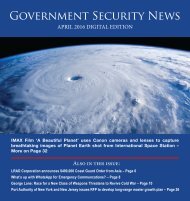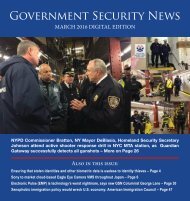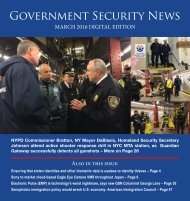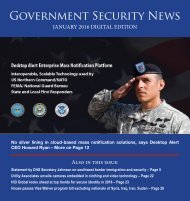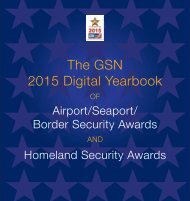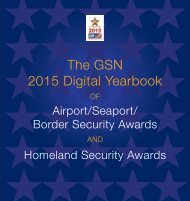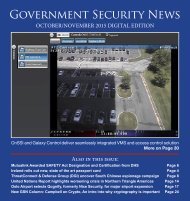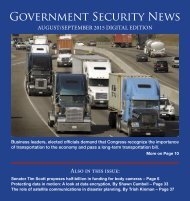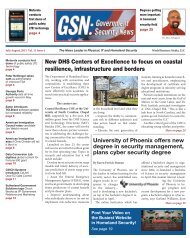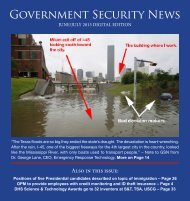GSN Dec 2015/Jan 2016 Digital Edition
You also want an ePaper? Increase the reach of your titles
YUMPU automatically turns print PDFs into web optimized ePapers that Google loves.
also made in the growing field of unmanned<br />
aircraft.<br />
As you have probably seen, the<br />
subject of small, unmanned aircraft<br />
has consumed a great deal of the<br />
FAA’s time in recent months. We are<br />
working to implement regulations<br />
that will enable us to safely integrate<br />
this promising segment of aviation<br />
into the world’s busiest and most<br />
complicated airspace system.<br />
Meanwhile, the industry itself is<br />
growing at a pace unlike anything<br />
we’ve seen since the dawn of the Jet<br />
Age.<br />
We learn every day about new<br />
and creative uses for these aircraft,<br />
whether it’s to deliver packages or<br />
enable companies to accomplish<br />
tasks such as remotely monitoring<br />
miles of railroad or pipeline.<br />
At the same time, these small aircraft—we<br />
call them Unmanned<br />
Aircraft Systems, you call them Remotely<br />
Piloted Aircraft Systems, but<br />
the rest of the world knows them<br />
as drones – are becoming the latest<br />
craze among tech-savvy consumers.<br />
Retailers estimate that as many as<br />
400,000 small unmanned aircraft<br />
will be sold during the holiday season<br />
in the U.S. Most will be piloted<br />
by operators who have little or no experience<br />
in aviation.<br />
We have already had several hundred<br />
instances in the U.S. in which<br />
pilots have reported these small aircraft<br />
have come into close proximity<br />
to manned flights. Many of them<br />
have been in airspace near airports,<br />
while a number have been at altitudes<br />
ranging from 1,500 feet to as<br />
high as 10,000 feet.<br />
As you might imagine, we are<br />
working to eliminate the likelihood<br />
of an unfortunate incident or accident.<br />
We are using every method<br />
at our disposal to engage these new<br />
aviators – and they are aviators. As<br />
we do so, we value the advice and<br />
experience of our international partners<br />
here in Israel and elsewhere.<br />
We recognize that we are all embarking<br />
together into yet another new age<br />
in the constantly changing world of<br />
aviation.<br />
As regulators, airline operators and<br />
business leaders and aviators, we are<br />
constantly called upon to make flying<br />
even safer. We have achieved an<br />
amazing track record together.<br />
One of the most important factors<br />
in the worldwide aviation safety record<br />
is the free exchange of information.<br />
We realized in the late 1980s<br />
and early 1990s that the industry<br />
would need to focus on intense data<br />
analysis to detect risk and prevent<br />
accidents or incidents from occurring.<br />
The industry adopted a wide array<br />
of programs that encouraged<br />
aviation professionals–be they pilots,<br />
flight attendants, mechanics or air<br />
traffic controllers–to voluntarily report<br />
safety events without jeopardizing<br />
their careers.<br />
Airlines and government safety<br />
authorities around the world used<br />
that information to jointly develop<br />
new safety protocols. We improved<br />
not only training, but the technologies<br />
we rely on to keep us safe as we<br />
jet from place to place at almost the<br />
speed of sound.<br />
As a result, we have all but eliminated<br />
the most common causes of commercial<br />
accidents – controlled flight<br />
into terrain, weather, wind shear and<br />
failure to complete checklists. All<br />
33<br />
told, our Commercial<br />
Aviation Safety<br />
Team reduced the<br />
risk of fatalities in<br />
U.S. commercial<br />
aviation by 83 percent<br />
over 10 years.<br />
We continue to work through the<br />
world’s international safety organizations<br />
to make flying safer, no matter<br />
where the wheels touch down. The<br />
path to success depends upon the<br />
free exchange of safety information<br />
and the willingness to always look<br />
for the next improvement. We are<br />
pleased to join you on this journey.<br />
Many people outside our industry<br />
probably aren’t aware of it, but some<br />
of the most valuable lessons about<br />
flying were learned in this part of<br />
the world. Antoine de St. Exupery,<br />
known to many as the author of the<br />
children’s book, “The Little Prince,”<br />
was actually a pioneering aviator<br />
who spent much of his time flying<br />
the airmail throughout the Middle<br />
East.<br />
He wrote an award-winning book,<br />
“Wind, Sand and Stars” in 1939, inspired<br />
by a plane crash that almost<br />
claimed the lives of St. Exupery and<br />
his navigator.<br />
St. Exupery offered several observations<br />
about flying under trying<br />
conditions. Back then, he was in<br />
open-cockpit biplanes. Most often,<br />
those flights occurred at night. Navigation<br />
was best accomplished by following<br />
the stars. As anyone who has<br />
spent any time in the desert knows,<br />
a sand dune in a sea of sand dunes<br />
makes a poor reference point.<br />
He writes about the loneliness of<br />
the desert and the importance of<br />
More on page 34



